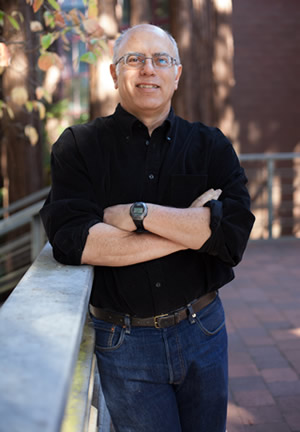By Ana Rita Neves
Posted: July 1, 2018
 Professor Manuel Ares Jr. is a Distinguished Professor in the Department of Molecular, Cell & Developmental Biology at the University of California, Santa Cruz. Professor Ares received his Ph.D. from the University of California in San Diego, where he studied cell cycle control of gene expression in Chlamydomonas. He then moved to Professor Alan Weiner’s lab at Yale University for post-doctoral studies where a chance conversation in the break room with Professor Joan Steitz redirected his scientific career. As Professor Ares recalled, “Hearing Joan describe her experiments triggered a memory of an odd result I had over a year earlier. I showed Joan my failed control, and she encouraged me to chase it—I was eventually able to describe the snRNA U2 from yeast and identify its gene.”
Professor Manuel Ares Jr. is a Distinguished Professor in the Department of Molecular, Cell & Developmental Biology at the University of California, Santa Cruz. Professor Ares received his Ph.D. from the University of California in San Diego, where he studied cell cycle control of gene expression in Chlamydomonas. He then moved to Professor Alan Weiner’s lab at Yale University for post-doctoral studies where a chance conversation in the break room with Professor Joan Steitz redirected his scientific career. As Professor Ares recalled, “Hearing Joan describe her experiments triggered a memory of an odd result I had over a year earlier. I showed Joan my failed control, and she encouraged me to chase it—I was eventually able to describe the snRNA U2 from yeast and identify its gene.”
Beyond this “accidental windfall,” it was the scientists working on splicing that drew him to this area of research. “The quality of the leaders as well as their commitment to integrity and to the community are the things that sustain a great field,” he said. “Learning about RNA from them has been profoundly satisfying for me.” Notably, Professor Ares has been an active member in both the splicing field and the broader RNA community (including serving as President of the RNA Society in 2011). “RNA researchers are outstanding scientists who are as supportive as they are critical, as friendly as they are smart; they are inclusive and worldly, dedicated to sustaining their field, and interested in the broadest set of biological phenomena possible.”
After more than 30 years in the field of RNA, Professor Ares remains fascinated by pre-mRNA splicing. Recently on sabbatical at UCLA, Los Angeles, with Professors Douglas Black and Tracy Johnson, he worked on understanding the origin of “split reads” in a variety of sequenced RNA libraries. He commented that “we think they are formed by the completed spliceosome failing to disassemble and doing secondary reactions on the lariat intron.” He added that “although I am not sure about the impact of wacky, off-the-rails spliceosome activities after the main job is finished, getting to work at the bench in someone else’s lab on something that looks weird is my idea of exciting science—and sabbaticals are the perfect time for risk taking!”
Professor Ares has two main pieces of advice for current trainees. The first is “research is hard, but the definition of success is multidimensional. Because there are so many facets to being a member of a scientific community, there are also many possibilities for success.” The second is, “if you find you need to learn something in order to progress, you study that thing.” He added, “Look into the future and anticipate the skills you will need to keep your practice current. Never consider your education to be complete.” Fitting advice for a veteran researcher who still thinks of himself as a trainee.
“There is no last word in science. It is a living conversation.”
Above all, though, Professor Ares believes that “being continuously successful means you practice science the best way you can every day.” However, he cautions that “perfect is the enemy of the next step forward” and that “there is no last word in science. It is a living conversation where it is possible to stutter or misspeak and to correct yourself or others; however, if you are afraid to speak, then you will fail to be part of the conversation.” He concluded that “nothing in biology makes sense except in light of RNA!”
Dr. Ares’s favorite RNA is yeast U2 (“easy!”). You can find him on twitter as @riboguy. He noted that he has “a friend I follow called @Ribohipster, and it is amazing how often he says what I am thinking – so check him out too!”
